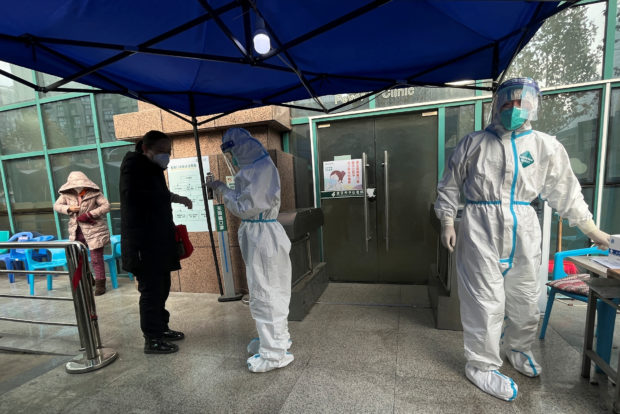New Year Eve spurs hope in China even as censors target online COVID-19 content

A medical worker in a protective suit checks a thermometer for a patient at the entrance to the fever clinic of the Central Hospital of Wuhan, amid of the coronavirus disease (COVID-19) outbreak, in Wuhan, Hubei province, China December 31, 2022. REUTERS
WUHAN/BEIJING — New Year’s Eve in China prompted an outpouring of reflection online, some of it critical, about the strict zero-COVID policy the country adhered to for almost three years and the impact of its abrupt reversal this month.
The sudden change to live with the virus has prompted a wave of infections across the country, a further drop in economic activity and international concern, with Britain and France the latest countries to impose curbs on travelers from China.
Three years into the pandemic, China this month acted to align with a world that has largely reopened to live with COVID, after unprecedented protests that became a de-facto referendum against the zero-COVID policy championed by President Xi Jinping.
The protests were the strongest show of public defiance in Xi’s decade-old presidency and coincided with grim growth figures for China’s $17 trillion economy.
On Saturday, people in the central Chinese city of Wuhan, the epicenter of the pandemic, expressed hope the new year would bring better fortune.
Article continues after this advertisementSeveral people in Wuhan bemoaned how widely the virus has spread after lifting of all the pandemic curbs, with one, 45-year-old Chen Mei, saying she just hopes that in 2023 her teenage daughter can resume normal classes over the long term.
Article continues after this advertisement“When she can’t go to the school and can only have classes online it’s definitely not an effective way of learning,” she said.
“Kids don’t have such good self discipline. And then for us adults sometimes because of the epidemic controls we have been locked up at home. It’s definitely had an impact.”
Thousands of users on China’s Twitter-like Weibo criticised the removal of a viral video made by local outlet Netease News that collated real-life stories from 2022 that had captivated the Chinese public.
Many of the stories included in the video, which by Saturday could not be seen or shared on domestic social media platforms, highlighted the difficulties ordinary Chinese faced as a result of the strict COVID policy.
Weibo and Netease did not immediately reply to a request for comment.
One Weibo hashtag about the video garnered almost 4 million hits before it disappeared from platforms around noon on Saturday. Social media users created new hashtags to keep the comments pouring in.
“What a perverse world, you can only sing the praises of the fake but you cannot show real life,” one user wrote, attaching a screenshot of a blank page that is displayed when searching for the hashtags.
The disappearance of the videos and hashtags, seen by many as an act of censorship, suggests the Chinese government still sees the narrative surrounding its handling of the disease as a politically sensitive issue.
Overwhelmed hospitals, funeral homes
The wave of new infections has overwhelmed hospitals and funeral homes across the country, with lines of hearses outside crematoria fuelling public concern.
China, a country of 1.4 billion people, reported one new COVID death for Friday, the same as the day before – numbers which do not match the experience of other countries after they reopened.
UK-based health data firm Airfinity said on Thursday around 9,000 people in China are probably dying each day from COVID. Cumulative deaths in China since Dec. 1 have likely reached 100,000, with infections totalling 18.6 million, it said.
At the central hospital of Wuhan, where former COVID whistleblower Li Wenliang worked and later died of the virus in early 2020, patient numbers were down on Saturday compared with the rush of the past few weeks, a hazmat-suit wearing worker outside the hospital’s fever clinic told Reuters.
“This wave is almost over,” the worker said.
A pharmacist whose store is next to the hospital said most people in the city had now been infected and recovered.
“It is mainly old people who are getting sick with it now,” he said. “They have underlying conditions and can get breathing issues, lung infections or heart problems.”
New year, new challenges
In the first indication of the toll on China’s giant manufacturing sector from the change in COVID policy, data on Saturday showed factory activity shrank for the third straight month in December and at the sharpest pace in nearly three years.
Besides the growing economic toll, rising infections after lifting of the restrictions also have prompted international concern, particularly regarding the possibility of a new, stronger variant emerging out of China.
Britain and France became the latest countries to require travellers from China to provide negative COVID-19 tests. The United States, South Korea, India, Italy, Japan and Taiwan have all imposed similar measures.
The World Health Organization on Friday once again urged China’s health officials to regularly share specific and real-time information on the COVID situation in the country, as it continues to assess the latest surge in infections.
China’s narrow criteria for identifying deaths caused by COVID-19 will underestimate the true toll of the pandemic and could make it harder to communicate the best ways for people to protect themselves, health experts have warned.
RELATED STORIES
Global alarm grows over China’s COVID-19 surge
COVID-19 travel curbs against Chinese visitors ‘discriminatory’–state media
For more news about the novel coronavirus click here.
What you need to know about Coronavirus.
For more information on COVID-19, call the DOH Hotline: (02) 86517800 local 1149/1150.
The Inquirer Foundation supports our healthcare frontliners and is still accepting cash donations to be deposited at Banco de Oro (BDO) current account #007960018860 or donate through PayMaya using this link.